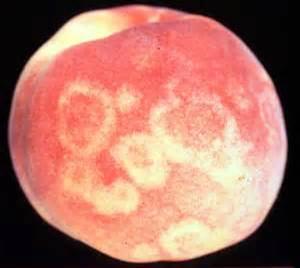GMO vs. Inter-Specific Hybrids

Peach infected with Plum Pox virus. Plum Pox is a devastating disease that must not be allowed to become established in the US.
Grandpa Will Explain the Vast Differences Between the Two
To many, the term “GMO” (Genetically Modified Organism) conjures up images of “Frankenfood”. Several people fear “GMO” and there is great debate going on all over the world about these foods. There is also plenty of confusion as to what exactly they are and how safe they are for us to eat.
In truth, all fruits have been manipulated genetically since the days Mendel started to understand the basics of genetics and how genes carried characteristics in the lowly pea. By understanding genetics, and by cross-breeding fruit varieties, we have bred thousands of different varieties of fruit which we eat every day. These varieties have either been found in nature, where Mother Nature allows different varieties to cross-pollinate and become new and different cultivars; or have been intentionally cross-pollinated by breeders who specifically selected the parents and bred them together. The breeders then evaluated their progeny, and hopefully selected a few that showed improvements. These “natural” breeding methods are certainly not considered “GMO” by almost all people with common knowledge of basic genetics.
Most people consider “GMO” to be the use of methods which are far outside those of natural methods. Basically, it comes down to Mother Nature vs. Science. Often, this involves using specific bacteria in laboratory conditions to “insert” genes into a target cell and force it to express a trait that it normally would not have in nature. The best examples are the many varieties of corn and soybeans which are resistant to the commonly used herbicide glyphosate (trade name Roundup®). The resistance to this herbicide is not something that is commonly found in nature. However, it has allowed efficiencies in producing those crops and getting the production to have greater success. What the long term effects of either the “GMO” infused corn or soybean is something our descendants may find out in the near future. The jury is still out on that debate though.
Many non-deciduous fruits, such as papaya (currently on the produce shelves today) may have been genetically modified to resist a devastating and lethal virus that has been infecting numerous papaya groves all around the world. Without this resistance, many papaya growers would be out of business and there would be a papaya shortage as well.
Natural resistance is not easy to introduce using common natural breeding methods. The threat of a Plum Pox, a lethal and devastating virus introduced from overseas has encouraged some USDA scientists to find ways to introduce plum pox resistance into stone fruit via “GMO” methods. So far, they have devised a plum that is resistant, but it is not approved or being introduced into the market yet. It is possible that it may be used in the future as a conventional parent for trying to breed more plum pox resistant stone fruits.
There is only one deciduous fruit tree brand considered “GMO” in the marketplace today. The Artic(R) brand of apples are non-browning apples and currently only being marketed as packaged slices, and not as a fresh market apple. Their brand is being highly controlled by only one company and its apples will likely never be released as varieties that any backyard grower could get their hands on.
Grandpa does not offer, and will not be offering, any fruit varieties that are considered “GMO”. All of Grandpa’s fruit varieties have been bred or selected using the normal, natural methods.
“Inter-specific Hybrids” such as; plum-apricot, plum-cherry, and plum-peach crosses are indeed “non-GMO”. They are bred using the conventional breeding methods that have been used since Luther Burbank and are found in nature. However, these are unique in that the breeder has to finely manipulate the cross-breeding and pollination processes. Fruits like plum, cherry and peach often do not bloom at the same times. If they happen to cross-pollinate, the seed that is formed may abort or develop abnormally. So, the breeder of these “inter-specific” stone fruits has to adjust when the parents bloom, so that he can harvest the pollen of the father and hand-pollinate to the mother flower. In addition, he usually will have to harvest and germinate that seed very carefully in order to help it grow into a plant. There is no laboratory gene insertion or “cellular-tinkering” going on here, just novel horticultural techniques and the patience of a passionate farmer. There have been some very interesting “inter-specific” stone fruit cultivars developed by using these methods. Many of the fruits are on the produce shelves today, like apriums, pluots, plumcots, etc.
Interestingly enough, nature often hybridizes species which may not be closely related naturally. So many of the new varieties of apples have parentage from widely dispersed gene pools. However, this does not make them “GMO”. Because scientists are understanding genetics much better these days, they are starting to identify and understand more and more specific genes and what these genes do. They now try to “read” the genetic makeup of cells, to hasten the speed by which new varieties can be bred and introduced. Of course, in medicine this same thing is happening and many diseases are now understood more than they used to be back in the day. This is because doctors know that specific genes can be the cause of specific diseases.
Grandpa’s Orchard Fruit trees are always “non-GMO”